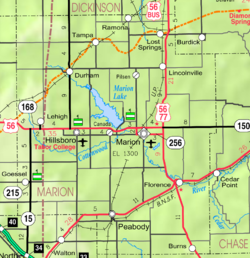2020 census
The 2020 United States census counted 234 people, 83 households, and 56 families in Burns. [18] [19] The population density was 680.2 per square mile (262.6/km2). There were 104 housing units at an average density of 302.3 per square mile (116.7/km2). [19] [20] The racial makeup was 96.58% (226) white or European American (96.58% non-Hispanic white), 0.0% (0) black or African-American, 0.0% (0) Native American or Alaska Native, 0.0% (0) Asian, 0.0% (0) Pacific Islander or Native Hawaiian, 0.0% (0) from other races, and 3.42% (8) from two or more races. [21] Hispanic or Latino of any race was 0.43% (1) of the population. [22]
Of the 83 households, 32.5% had children under the age of 18; 49.4% were married couples living together; 22.9% had a female householder with no spouse or partner present. 25.3% of households consisted of individuals and 13.3% had someone living alone who was 65 years of age or older. [19] The average household size was 3.3 and the average family size was 3.6. [23] The percent of those with a bachelor’s degree or higher was estimated to be 6.8% of the population. [24]
29.9% of the population was under the age of 18, 9.8% from 18 to 24, 23.9% from 25 to 44, 22.6% from 45 to 64, and 13.7% who were 65 years of age or older. The median age was 33.3 years. For every 100 females, there were 87.2 males. [19] For every 100 females ages 18 and older, there were 102.5 males. [19]
The 2016-2020 5-year American Community Survey estimates show that the median household income was $59,167 (with a margin of error of +/- $14,882) and the median family income was $67,083 (+/- $8,721). [25] Males had a median income of $41,250 (+/- $13,531) versus $20,625 (+/- $11,752) for females. The median income for those above 16 years old was $28,333 (+/- $5,497). [26] Approximately, 11.8% of families and 19.4% of the population were below the poverty line, including 23.4% of those under the age of 18 and 13.8% of those ages 65 or over. [27] [28]
2010 census
As of the census [29] of 2010, there were 228 people, 93 households, and 59 families residing in the city. The population density was 651.4 inhabitants per square mile (251.5/km2). There were 112 housing units at an average density of 320.0 per square mile (123.6/km2). The racial makeup of the city was 96.9% White, 1.3% African American, 0.4% Native American, 0.4% Pacific Islander, and 0.9% from two or more races. Hispanic or Latino of any race were 0.9% of the population.
There were 93 households, of which 29.0% had children under the age of 18 living with them, 51.6% were married couples living together, 7.5% had a female householder with no husband present, 4.3% had a male householder with no wife present, and 36.6% were non-families. 32.3% of all households were made up of individuals, and 16.2% had someone living alone who was 65 years of age or older. The average household size was 2.45 and the average family size was 3.14.
The median age in the city was 38 years. 25% of residents were under the age of 18; 8.8% were between the ages of 18 and 24; 23.2% were from 25 to 44; 27.1% were from 45 to 64; and 15.8% were 65 years of age or older. The gender makeup of the city was 53.9% male and 46.1% female.





